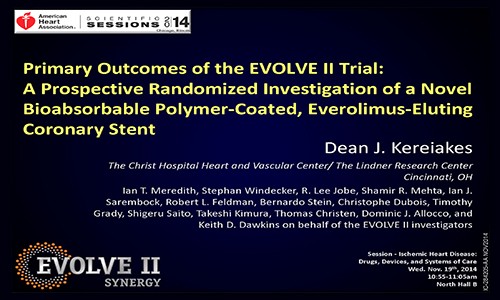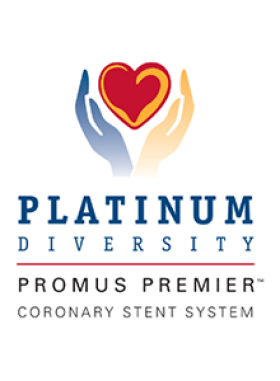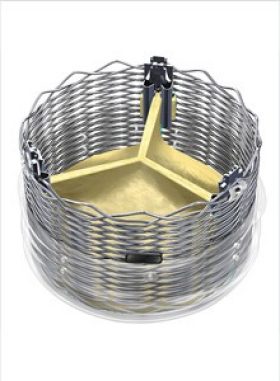The Future of Bioabsorbable DES in Context
In the most complex patient population ever studied in a U.S. Pivotal Trial, the SYNERGY™ Stent demonstrated outstanding outcomes:
- ZERO definite ST after 24 hours
- ZERO definite/probable ST after 6 days
- Exceptionally low 0.4% ARC definite/probable ST at 1-year
- Primary Endpoint of Target Lesion Failure (TLF) Met in both Intent to Treat and in Per Protocol Patient Populations
- More-comers population
- >60% ACS
- 25% MI
- 31% diabetes
- 24% small vessels (<2.25mm)
- 19% long lesions (>20mm)
- ≥75% AHA/ACC B2/C lesion morphology
- SYNERGY Stent displayed statistically greater technical success than PROMUS Element with delivery and deployment (98.3% SYNERGY vs 96.9% PROMUS Element)
More Information
Interview Video Transcript
Craig Thompson: Hello. I'm Craig Thompson, Chief Medical Officer of Interventional Cardiology for Boston Scientific. I'm at the American Heart Association 2014 annual Scientific Sessions and joined today by Dr. Dean Kereiakes. Dean is a true luminary in Interventional Cardiology. He's with the Christ Hospital Heart and Vascular Center and the Lindner Research Institute. Dean, welcome this morning.
Dean Kereiakes: Thank you for having me.
Craig Thompson: Dr. Kereiakes is the principal investigator of the EVOLVE II IDE pivotal trial program and just presented the data this morning at the AHA. I was hoping that you could catch us up to speed on where things stand with EVOLVE. The study product is the SYNERGY stent platform. Perhaps you can tell us a bit about what SYNERGY is.
Dean Kereiakes: Yeah. SYNERGY is, I think a platform that's been designed specifically focused on improving patient-related outcomes, meaning facilitating and expediting healing, because it's an ultra-thin strut. It's 29,000th of an inch strut thickness, 74 microns. It's a very flexible platform, so it has greater conformability and flexibility, less geometric distortion of the artery, which we know is not a good thing.
It has an ultra-thin 4-micron thick polymer coating, PLGA polymer coating, on only the abluminal surface, and it elutes everolimus in the same dose density as the Promus Elements Plus. It’s 100 mg/cm squared. The important thing here is that every aspect that I just described is optimal, if you will, compared to other designs for enhancing or facilitating healing of the artery.
Craig Thompson: Very good. The pivotal trial, the EVOLVE II trial, and the EVOLVE family of trials you just presented this morning, perhaps you could tell us a little bit about what the design of the trial was and the purpose.
Dean Kereiakes: Sure. The EVOLVE first human use was randomized, and it had a primary angiographic endpoint, late lumen loss at 6 months. It proved non-inferiority for late lumen loss and angiographic endpoint in 6 months between the SYNERGY and the Promus Element stent. It wasn't large enough to have a clinical endpoint. This, for regulatory approval, US FDA approval, had to been large enough and it's powered to show non-inferiority at target lesion failure which is a composite endpoint in cardiac related death, target vessel-related myocardial infarction, and clinically indicated target lesion revascularization, those three components. It is adequately powered to show non-inferiority at one year.
There's 1,684 patients randomly assigned one-to-one, either Promus Element Plus or SYNERGY. The endpoint estimate was 8% with a non-inferiority margin of 4.4%. What we showed both by intention to treat and in the per protocol as treated population was clearly three zeros in both P values. The SYNERGY was non-inferior. It is not inferior to the Promus Element Plus for target lesion failure at one year. It would be viewed as very successful trial and that it hit its primary endpoint.
Craig Thompson: You had mentioned one of the purposes for building this stent platform as an evolution upon DES was trying to facilitate healing. Any signs or comforting findings within the trial that you've seen in this regard?
Dean Kereiakes: Let me say this is interestingly the most complex group of patients both clinically and angiographically meaning over a third had unstable angina, almost a third had diabetes, over a quarter were bio-marker positive, had myocardial infarction diagnosed before PCI. 75% of all the lesions in both groups were B2/C AHA ACC lesion classification by the core lab. Despite that in the SYNERGY treated population, ARC definite/probable stent thrombosis was seen in only three patients to one year and there were no episodes of definite stent thrombosis beyond the first 24 hours. In those two, one patient actually never received aspirin and they were both very complex issues. Small vessels, long lesions and had side branches that they had stented across in those two cases.
Those are things that we see in practice but they have other explanations for why those patients would be at very high risk to have a stent thrombosis event. It's remarkable that despite the complexity, clinically and angiographically, that stent thrombosis rates were so low.
Craig Thompson: Would you expect there to be a class effect in the context of these resorbable polymer drug eluting stents?
Dean Kereiakes: I think absolutely not. I've used this term, bio degradable polymer, bioresorbable polymer DES are not all created equal. They're separated by strut thickness. They're separated by platform design with respect to flexibility, conformability, by polymer composition, distribution, whether it's conformal or abluminal only, and by polymer load and their time course for resorption. Many of them like the first gen, Nobori or Biomatrix, they take 9 months for the polymer to go away and the struts are very thick.
This is an iteration on multiple levels designed as an improvement.
Craig Thompson: Very good. Any final takeaways from the EVOLVE II program?
Dean Kereiakes: You know, we hit our endpoint. I'm looking forward to having it commercially available for use in the United States. On the panel today were some of my European colleagues who leaned over and told me that it was the most deliverable and user-friendly from an operator standpoint. Of course I knew that because we're high enrollers. I can tell you from an operator's standpoint it makes tough cases easier because of its low profile, its flexibility, deliverability. From a patient standpoint hopefully it will make the clinical outcomes better, too.
Craig Thompson: Hopefully so. Thank you for taking time this morning to catch us up to speed with the clinical trials program. Appreciate it.



















